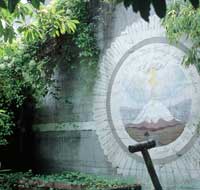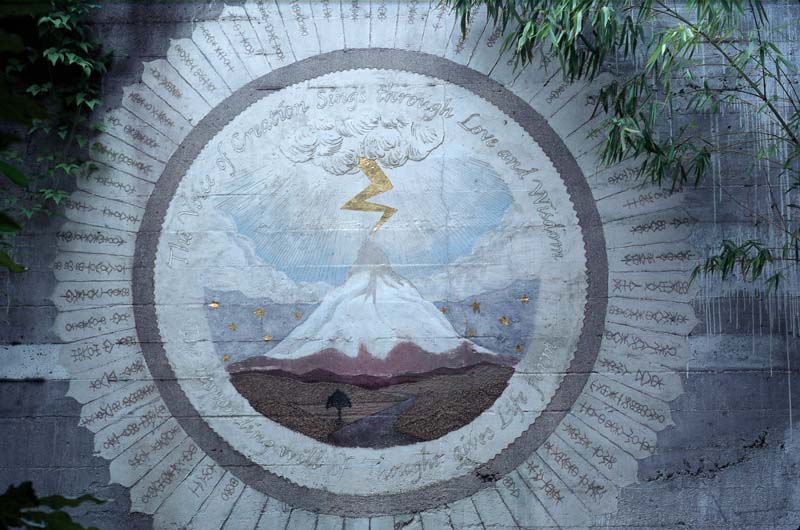 Back in the mid 1990s, on a quest for good Thai food, my partner and I happened upon an artistic oasis in Lake Oswego, an upscale suburban burg a bit south of Portland, Oregon.
Back in the mid 1990s, on a quest for good Thai food, my partner and I happened upon an artistic oasis in Lake Oswego, an upscale suburban burg a bit south of Portland, Oregon.
Tucked away in a neglected alley in the center of town, we found a wall covered in art.
It was a low gray wall facing a small lot with a run-down building at the back, and everything was covered in a tropical forest of weeds and vines. What caused us to stop and look was a mural, which was wholly uncovered on the alley-side of the wall. We waded into the weeds and could see that the mural extended further along the length of the wall. What a find! I felt like Lucy discovering a fistful of pine boughs instead of a fur coat in the Wardrobe.
My husband and I were much more inclined in those days to photograph whatever we found, so we trooped home and returned with cameras and tripods. We spent several hours photographing the “Know Before Whom You Stand” mural (as we called it). It was like a mysterious expedition, complete with tromping through weeds, and pulling aside old vines to reveal new, exotic wonders.
 The trees in the painting contain a codex — an alphabet to decipher the code used throughout the works–which the artist calls the “living script.” On closer examination you find that much of the mural is made with sand and carefully cemented rocks and seashells, smooth stones, tiny pieces of driftwood, and a highly textured paint like cake frosting. It was an improbable vertical sand painting.
The trees in the painting contain a codex — an alphabet to decipher the code used throughout the works–which the artist calls the “living script.” On closer examination you find that much of the mural is made with sand and carefully cemented rocks and seashells, smooth stones, tiny pieces of driftwood, and a highly textured paint like cake frosting. It was an improbable vertical sand painting.
The center wheel, dominated by Hebrew-looking letters, is an ode to the Universe, stating “Know Before Whom You Stand.” Note the exquisite texturing in this piece.
In the farthest corner, partially obscured by vegetation, is a lightning-topped mountain encircled by phrases including “Thought Gives Life Form.” The flower-petal rays enclose names, I assume of friends and family, inscribed in the artist’s code.
The artist’s name, revealed by a smooth, black rock among the trees, is Roger A. Long. He created this wonderful mural in the late 1960s. We later learned this wall was (or was near) an old studio belonging to the artist.
This magnificent artwork was destroyed by the city in 2000. In its stead is the Lake Oswego “Millennium Park.” Where the mural-covered wall stood before, there is now a sloping lawn. I still can’t drive through Lake Oswego without thinking of the loss.


The artist’s signature on a flat stone on the wall.

Just one more thing: This adventure occurred more than 20 years ago, and I challenged myself to write about this experience entirely from memory without looking at any of the photos. After taking a look, I see that the lot off that little alley was much less wild and overgrown than I remembered, in fact it was quite trim near the front. This goes to show the magic of that day, how it turned my memory of a quiet little suburban alley into my exotic story of discovery! Memory is so malleable, and I guess in that way, reality can be, too.
Mr. Long is still living in Lake Oswego and is still creating his “sand-painting” masterpieces. Here’s more from Roger Long.